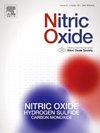急性硝酸补充对静息和交感神经兴奋时浅管静脉血管反应的影响。
IF 3.2
2区 生物学
Q2 BIOCHEMISTRY & MOLECULAR BIOLOGY
引用次数: 0
摘要
补充硝酸盐(NO3-)后增加一氧化氮(NO)活性和/或NO前体水平对静脉血管控制的影响尚不清楚。我们研究了急性硝酸盐补充对静息和交感神经兴奋(如静态运动和肌肉代谢反射)时单个导管静脉血管反应的影响。参与者是15名健康的年轻人,他们要么喝甜菜根汁(BRJ, 140毫升;~ 8 mmol NO3-)或对照饮料(西梅汁;CON, 166 mL;< 0.01 mmol NO3-),随机交叉研究设计。在饮用分配的饮料2小时后,每个参与者休息4分钟,然后使用右臂进行持续的等长前臂运动(前臂运动),以其最大自主收缩的45%进行1.5分钟,随后是2分钟的恢复期,运动臂动脉闭塞,仅激活肌肉代谢反射。测量左非运动臂平均动脉压(MAP)、心率(HR)和浅静脉横截面积(CSAvein)。摄入BRJ使血浆硝酸盐浓度升高(p < 0.05)。所有静息参数与CON和BRJ相似。运动后MAP、HR升高,csavin降低(p < 0.05),除HR外,恢复期间均保持上述变化。BRJ组MAP的增加低于CON组(p < 0.05),但csavin减少的幅度在两组之间没有差异。这些发现表明,在单个导管静脉中,BRJ摄入增加的NO前体不会改变静息时静脉血管张力,也不会改变前臂运动或肌肉代谢受体激活时交感静脉收缩。本文章由计算机程序翻译,如有差异,请以英文原文为准。

Effect of acute nitrate supplementation on the superficial conduit venous vascular response at rest and during sympathoexcitation
The effects of increased nitric oxide (NO) activity and/or NO precursor levels following nitrate (NO3−) supplementation on venous vascular control remain poorly understood. We investigated the effect of acute NO3− supplementation on the venous vascular response of a single conduit vein at rest and during sympathoexcitation (e.g., static exercise and muscle metaboreflex). Participants were 15 healthy young adults who consumed either beetroot juice (BRJ, 140 mL; ∼8 mmol NO3−) or a control beverage (prune juice; CON, 166 mL; <0.01 mmol NO3−) following a random crossover study design. Two hours after consuming the allocated beverage, each participant rested for 4 min and then performed a continuous isometric forearm exercise (forearm exercise) using the right arm at 45 % of their maximal voluntary constriction for 1.5 min, followed by a 2-min recovery period with arterial occlusion of the exercising arm to activate the muscle metaboreflex only. Mean arterial pressure (MAP), heart rate (HR), and the cross-sectional area of the superficial vein in the left non-exercising arm (CSAvein) were measured. BRJ intake increased the plasma NO3− concentration (p < 0.05). All resting parameters were similar with CON and BRJ. MAP and HR increased and the CSAvein decreased with exercise (p < 0.05), and these changes were maintained during recovery, except for HR. The increase in MAP was lower in the BRJ group than in the CON group (p < 0.05), although the magnitude of the CSAvein decrease did not differ between the groups. These findings suggest that, in a single conduit vein, the increasing NO precursors by BRJ intake does not alter either the venous vascular tone at rest or the sympathetic venoconstriction during forearm exercise or during the activation of muscle metaboreceptors.
求助全文
通过发布文献求助,成功后即可免费获取论文全文。
去求助
来源期刊

Nitric oxide : biology and chemistry
生物-生化与分子生物学
CiteScore
7.50
自引率
7.70%
发文量
74
审稿时长
52 days
期刊介绍:
Nitric Oxide includes original research, methodology papers and reviews relating to nitric oxide and other gasotransmitters such as hydrogen sulfide and carbon monoxide. Special emphasis is placed on the biological chemistry, physiology, pharmacology, enzymology and pathological significance of these molecules in human health and disease. The journal also accepts manuscripts relating to plant and microbial studies involving these molecules.
 求助内容:
求助内容: 应助结果提醒方式:
应助结果提醒方式:


